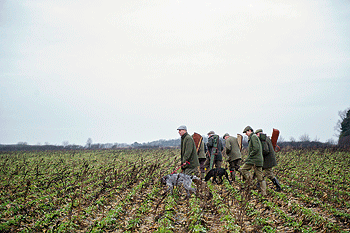A snapshot of the sport

Have you ever wondered how your shoot?s finances compare with other shoots in the UK? This year?s Shoot Benchmarking Survey, conducted by the website GunsOnPegs.com and rural property consultants Smiths Gore should give you a clearer idea. The survey sheds some much-needed light on how shoots up and down the UK have fared over the past 12 months.
At last weekend?s CLA Game Fair, the results of the second nationwide survey were revealed. In total, 110 shoots took part, an increase on last year, and between them they accounted for 2,400 shoot days, 350,000 acres and 1.1million pheasants and partridges. The data provides greater clarity of the economic realities of running a shoot and demonstrates how shoots could work to improve their bottom line.
The answers to the survey uncovered a whole raft of information, including the average number of birds released, remuneration for gamekeepers, overage policies,profitability as well as the average price per bird.
James Horne, managing director of GunsOnPegs, says some of the statistics make for uncomfortable reading: ?The results may act as a wake-up call to the industry ? we are seeing a greater focus on customer service and more innovative approaches to marketing days. The full results give a real insight into how the industry coped in the aftermath of the economic downturn.?
Commercial shoot losses
Perhaps one of the most startling findings is the fact that only two-thirds of commercial shoots made a profit in 2010-2011. ?Despite shoots trying to control costs, nearly half of them are still making a loss. This cannot be sustainable in the long term,? warns David Steel, head of sporting at Smiths Gore.
So why are so many shoots making a loss? ?Put simply, the average variable cost of putting a bird down rose from £7.33 last year to £8.08 this year ? an increase of 10 per cent,? says David. ?On average, commercial shoots did not increase the price they charge per pheasant or partridge and so their net income per bird shot dropped. Average profit levels have fallen from £7.92 per bird shot to just £5.93.?
While commercial shoots held the price they charge per bird, non-commercial shoots adopted a different strategy. They increased their charges by £2 to £3 per bird compared with last year; however, they still charge less, especially when VAT is added by commercial shoots (70 per cent charge VAT).
In light of this, shoots did try to reduce their costs, however. Last year, they cut fixed costs such as staff salaries, rent and vehicle costs by an average of 8 per cent. However, variable costs rose for both commercial and non- commercial shoots, mainly due to increases in feed, fuel and beaters? costs.
Just as interesting is the revelation that many shoots have tightened up their overage policy. The results indicate that more shoots are not charging for any overage at all, fewer shoots are offering 10 per cent leeway and more shoots are charging by the total number of birds shot.
Overage charges
?We know that the overage policy of a shoot can make a substantial difference to the decision for a team of Guns to return,? says James. ?One of the most frequent complaints we receive concerns overage charges with Guns feeling they have been misled and overcharged.?
James adds that a team ought to know where they stand before they commence shooting. ?Being told to stop at lunch or pay more is extremely awkward for both the team and the host Gun. This is the reason shoots are either not charging for overage or being clear that you pay for what you shoot.?
Of course, this can work both ways. In the event of underage, the Guns pay for what has been shot. Nowadays, birds are simply too expensive for an overage policy to work.
For example, a 300-bird day at plus or minus 10 per cent could either cost the shoot £1,080 extra or equally under supply a team of eight Guns by £135 per gun.
“Customer service is key,” says James. “Shoots are in the entertainment industry and must ensure smiling faces at the end of the shoot. What the trend suggests is that shoots are becoming more alert to this fundamental need. It could also help explain why the top 25 per cent of shoots are fully booked within three months of the end of the season and why nearly all of this is repeat business.?
The shoot staff remuneration data also makes for interesting reading. Shoots provided the details of salaries, packages and benefits for 166 staff. Average salaries were unchanged, but the benefits keepers receive, including payments for utility bills, clothing allowances and keepers? days, have been reduced in an attempt to control costs. Beater and picker-up costs are rising, with shoots spending a third more on beaters and pickers-up than in 2009-2010. Commercial shoots pay around £5 or more per day than non-commercial ones.
Benchmark for the future
David urges shoots to take part in the survey in the future. ?If you have not already completed the survey, please take part next year. Rest assured, the all the information provided by shoots is kept entirely confidential and anonymous, and the results provided by respondents will greatly help all shoots which complete the survey to provide a benchmark against trends for the future.?
As a spin-off from the Shoot Benchmarking Survey, for their next project GunsOnPegs and Smiths Gore are planning regional shoot seminars for groups of 10 shoots or more. The purpose of the seminars will be to explore shoot performance and profitability.
To find out further details, contact GunsOnPegs on 020 7491 1363 or Smiths Gore on 01904 756316








